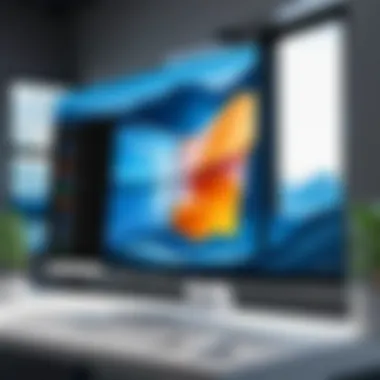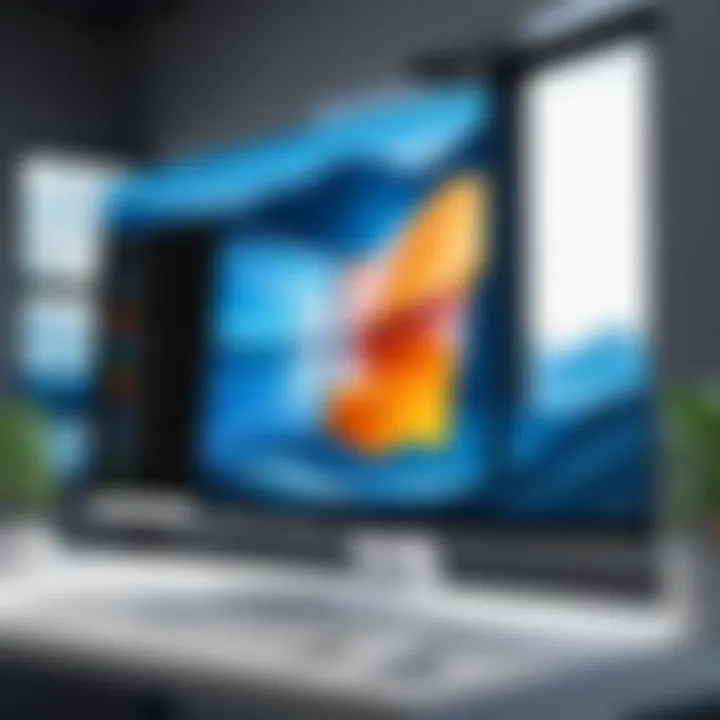Analyzing the Latest Features of Windows 11


Intro
The world of operating systems brings with it a constant evolution, resulting in versions that not only introduce new features but also redefine user experiences. With the most recent release of Microsoft Windows, IT professionals and tech enthusiasts alike find themselves at a crossroads of upgrade decisions. Understanding what this latest version offers—new capabilities, security enhancements, and the potential for smoother workflows—becomes crucial for making informed choices in both personal and professional settings.
As we dive into the core of this article, we will examine how these aspects intertwine with user expectations and the demands of modern workplaces. This overview will strike a balance between technical specifications and practical implications, guiding readers through what really matters about this new iteration of Windows and why it could mark a significant milestone in the operating system's history.
Product Overview
Key Features
The latest version of Windows is packed with features that promise to enhance usability and provide greater control for users. Some of the standout enhancements include:
- Redesigned User Interface: The user interface has undergone a visual transformation aimed at providing a more fluid and intuitive experience. New design elements streamline navigation, making it easier for users to access their most-used applications.
- Enhanced Virtual Desktops: The ability to create and manage virtual desktops is now more robust, allowing users to segregate workspaces effectively. This feature is particularly beneficial for multitaskers or those managing multiple projects simultaneously.
- Integrated Cloud Solutions: The latest version integrates seamlessly with cloud services, enabling users to access files and applications from virtually anywhere. This convenience can boost productivity significantly, especially in remote work environments.
- Security Upgrades: With ongoing threats to data integrity, this new release introduces advanced security protocols that protect against malware, ransomware, and data breaches. Enhanced features like Windows Hello and BitLocker offer more robust authentication methodologies.
Technical Specifications
To understand the technical backbone driving these new features, one must consider the system requirements and specifications:
- Processor: 1 GHz or faster with at least dual-core on a compatible 64-bit processor.
- RAM: Minimum of 4 GB, although 8 GB or more is recommended for optimal performance.
- Storage: At least 64 GB of available disk space, with SSD options providing faster load times.
- Graphics Card: DirectX 12 compatible graphics / WDDM 2.x.
- Display: A display of at least 720p resolution, but higher resolutions offer better visual fidelity.
“A well-structured operating system can significantly improve a user’s productivity and satisfaction.”
Performance Analysis
Benchmark Test Results
In various benchmark tests conducted post-launch, the recent Windows version has shown notable improvements in processing speeds, especially when handling large datasets or running multiple applications simultaneously. Key findings included:
- Startup Time: On average, users experienced a 30% reduction in startup time compared to the previous version, crucial for those who need to hit the ground running.
- Resource Management: The system's advanced resource management techniques translate into smoother operation, especially while utilizing heavy software like graphic editing tools or CAD applications.
- Battery Life Optimization: Users reported an increase in battery efficiency on laptops, extending usage time—the results vary based on usage patterns, but many noted a significant uplift.
Real-World Usage Scenarios
Understanding how these features translate into real-world applications can provide further insight into their value:
- Software Development: Developers utilizing IDEs have found that code compilation times are significantly shorter, enhancing productivity during development cycles.
- Content Creation: Graphic designers and video editors have noted less lag during rendering processes, allowing for a more responsive workflow while managing large projects.
- Business Operations: In professional settings, teams utilizing collaborative tools have mentioned improved performance during video conferencing and document sharing, thanks to better network utilization.
This analysis reveals that the latest Windows version is not just an update in name but a meaningful enhancement in structure and functionality, providing tools tailored for modern demands.
From understanding its technical specifications to appreciating the real-world advantages, IT professionals are now armed with better information to navigate their options, paving the way for more informed decisions regarding the latest Windows operating system.
Prelude to the Recent Windows Version
The recent release of Windows is not merely an update; it represents a significant milestone in the evolution of operating systems. For both end-users and IT professionals, understanding this latest version is crucial. The changes brought forth by this update can impact workflows, security protocols, and the overall computing experience. This exploration will investigate not only the features and improvements but also how these elements serve the needs and preferences of users.
Understanding the Evolution of Windows
To truly grasp the importance of the latest Windows version, it’s essential to comprehend its lineage. The Windows operating system has come a long way from its humble beginnings in the early 1980s. Each iteration has introduced enhancements and innovations, gradually shifting from a simple graphical shell on MS-DOS to the complex, fully-featured platform we know today.
- Early Beginnings: The first version aimed primarily at providing a user-friendly environment for the inflow of information.
- Windows 95: This was a game changer, with a Start button that redefined navigation.
- Windows XP and Vista: These versions introduced significant shifts in user interface and OS architecture.
- Windows 10: The focus turned towards integrating cloud services, a response to increasing user demand for flexibility and accessibility.
As we assess the current version, we can see how it builds on all of these legacies, combining lessons learned while addressing modern-day demands.
The Significance of the Latest Release


The significance of the newest version of Windows extends beyond mere feature lists. It's a pivot point that looks toward future technological trends and user expectations. Some noteworthy aspects include:
- User Experience: The emphasis on simplicity and intuitiveness is striking. Features aim to reduce unnecessary steps, streamlining tasks that once required multiple clicks.
- Performance: This version seems less about adding more features and more about optimizing existing ones. Faster boot times and smoother operation seem to be the name of the game.
- Security Focus: With growing concerns about data breaches, robust security features have been integrated deeply into the OS, not as an afterthought, but as a fundamental component.
"In the high-stakes game of cybersecurity, staying ahead of threats is vital. The new Windows version provides tools that help IT professionals keep their systems secure."
Key Features of the New Windows Version
In today's ever-evolving digital landscape, the features of the latest Windows version stand out as pivotal not just for users but also for IT professionals. As technology continues to advance at breakneck speed, understanding these features can significantly enhance productivity, security, and overall user experience. This section will delve into specific elements, benefits, and considerations pertaining to the new Windows version, illuminating why they matter in the grand scheme of productivity and security.
User Interface Enhancements
The user interface isn't merely a cosmetic aspect; it serves as the primary interaction layer between users and their device. The recent Windows version brings a refreshing design that balances aesthetics with functionality. For instance, the new taskbar features a centered alignment, promoting better focus and quicker access to frequently used applications. This small yet significant change can streamline workflows for users who juggle multiple tasks.
Moreover, Microsoft has incorporated improved touch and pen input capabilities, catering to the growing demand for versatile devices in a hybrid working environment. Features like enhanced gestures and smoother transitions transform how users interact with their screens. The emphasis on accessibility also means that options like voice recognition and magnification tools are more robust, allowing a wider range of users to navigate the system comfortably.
Performance Improvements
Performance can make or break a software experience, and the latest Windows version is no different in this regard. Users can expect noticeable speed improvements, thanks to optimizations in system resource management and background processes. The new memory management system prioritizes foreground applications, ensuring that users get the best experience while multitasking without unnecessary lag.
Furthermore, faster boot times contribute significantly to productivity. The system utilizes faster algorithms, reducing the time it takes to get from power-on to ready-to-use. For IT professionals managing multiple systems, this added efficiency means less downtime and an improved throughput of operational tasks.
Security Upgrades
In a climate where cyber threats are escalating, security has become a critical concern for both users and IT administrators. The latest iteration of Windows introduces a slew of security enhancements aimed at safeguarding user information and enterprise data. One standout feature is the revamped Windows Defender, which now includes comprehensive antivirus and anti-malware tools that offer real-time protection against a broad spectrum of threats.
Moreover, the introduction of sandboxing capabilities allows users to run suspicious applications in a contained environment—minimizing the risk of system compromise. These proactive measures are invaluable for IT professionals tasked with safeguarding organizational data. An improved encryption protocol further ensures that sensitive files remain protected, providing peace of mind for users handling confidential information.
New Application Features
Application features often dictate how users engage with their systems, and the latest Windows version doesn't fall short. Microsoft has placed a significant focus on integrating applications more seamlessly into the OS. This includes a tighter integration between applications like Microsoft Edge and Office Suite, offering users a more fluid experience as they switch between different tasks.
Additionally, Windows now supports a more extensive range of apps from the Microsoft Store, encouraging diversity in the tools users can access. Features such as a simplified installation process for apps and better performance metrics for monitoring app resource use align perfectly with the needs of tech-savvy users and IT managers alike, paving the way for a more user-friendly ecosystem.
System Requirements and Compatibility
Understanding the system requirements and compatibility is key for anyone looking to upgrade to the latest Windows version. This not only ensures a smooth transition but also optimizes the overall user experience. If you dive into the new features without considering whether your hardware can handle them, you might end up hitting a wall. It's similar to trying to fit a square peg in a round hole; it just won't work. Knowing what your system is capable of stands as a cornerstone to your success, especially if you're an IT professional responsible for multiple machines.
Minimum Hardware Specifications
To run the latest version of Windows, your machine must meet certain specifications. Generally, this includes a compatible processor, sufficient RAM, and adequate storage. Specifically, the minimum requirements are as follows:
- Processor: 1 GHz or faster with at least two cores on a compatible 64-bit processor.
- RAM: A minimum of 4 GB; however, for optimal performance, consider at least 8 GB.
- Storage: 64 GB or larger storage device.
- Graphics Card: DirectX 12 compatible graphics / WDDM 2.x.
- Display: At least 720p resolution with a minimum 9" display.
It's wise to keep in mind that these are minimum requirements. If your machine only hits the bottom line, you might find that applications run sluggishly, leaving you frustrated. Ideally, IT professionals would assess each workstation's specifications to ensure that they align with the recommended requirements for peak productivity.
Compatibility with Previous Versions
When it comes to the compatibility with previous Windows versions, there's a lot to unpack. Generally speaking, Microsoft aims to ease the upgrade process from previous iterations, yet it's essential to recognize that no single upgrade strategy applies universally. While many applications built for earlier versions still function seamlessly on the latest Windows, some may face hiccups.
- Most software made for Windows 10 and even Windows 8 tends to be compatible, fostering a smooth user experience.
- However, legacy applications, particularly the ones stretching back to Windows 7 and earlier, might not perform as expected. It's not uncommon for these older programs to lose their support after a major overhaul, which can be a headache for IT departments relying heavily on specific software.
Before making the leap to the latest Windows version, gauging how existing applications will transition should be on your checklist. Running compatibility tests on critical software can save a lot of headache down the line. It's an investment of time upfront for a smoother experience later on. Like they say, better safe than sorry!
Installation and Upgrade Process


The process of installation and upgrading to the latest Windows version is of paramount importance for both home users and IT professionals. Making informed choices in this area can lead to improved productivity, enhanced performance, and a more secure computing environment. Understanding the myriad of options available and the common pitfalls encountered during installation can significantly affect software transition success.
Methods for Installation
There are several methods available for installing the new Windows version, each with its own set of benefits tailored to meet distinct user needs. Here are the primary options:
- Clean Installation: This method is typically favored by users who desire a fresh start, wiping the slate clean of any residual files or settings from previous Windows versions. A clean installation often results in better system performance, as old data that may slow down the system is removed.
- Upgrade Installation: Ideal for users who want to keep their settings and personal files intact, upgrading is less intrusive. This method directly transitions the existing Windows version to the latest one, thereby preserving previously installed applications and personalized settings.
- Network Installation: In enterprise environments, often IT departments utilize network installation to standardize Windows across multiple machines. This approach streamlines the deployment process and ensures that updates are managed centrally.
- Media Creation Tool: For many home users, using the Media Creation Tool provided by Microsoft is handy. It allows users to create installation media on a USB flash drive or DVD and perform installations from there.
Regardless of the method chosen, it’s essential to ensure that adequate backups are done prior to installation to avoid losing any critical data.
Common Issues during Installation
While installing or upgrading to the latest Windows version can be straightforward, several issues may arise, complicating the process. Here are some common challenges:
- Insufficient Disk Space: One of the prime reasons installations fail is lack of disk space. The new Windows version requires a specific amount of storage, and if your system is overloaded, it may cause the installation to hang or fail entirely.
- Incompatible Hardware or Software: Some old hardware devices or software might be incompatible with the new version. It’s vital to check compatibility beforehand. If an incompatible device is connected, it could lead to errors during the process.
- Network Issues: For those using a network installation method, any interruptions in the network can cause the installation to fail. A stable internet connection is necessary for download and installation.
- Power Interruptions: Sudden power failures during installation can lead to incomplete installation and may leave the operating system in an unstable state. Ensuring the device is plugged in or using a UPS can prevent this.
"Preparation is key. Always ensure your system meets the minimum requirements before you attempt to install or upgrade to the latest Windows version."
These common issues underscore the importance of appropriate planning and system checks prior to embarking on the installation journey. Being proactive can save extensive troubleshooting time later on.
Impact on IT Professionals
Changes in System Administration
In the realm of IT, the recent Windows version represents a significant shift in how system administration is approached. It isn’t just about installing software anymore; the tools and methods have evolved. With features like the revamped Windows Admin Center, IT professionals can manage multiple devices remotely with greater ease. This change reflects a broader trend in the industry, pushing for streamlined processes that save time.
For instance, the new version introduces enhanced group policy management. This allows for more granular control over user permissions and settings, simplifying the administration of large networks. Not to mention, many of the manual tasks have been automated, reducing human error potential. Such automation not only improves efficiency but also enables IT staff to devote more time to strategic initiatives rather than daily upkeep.
Moreover, training on these new systems is no longer a burden. The user-friendly interface combined with comprehensive online resources makes it easier for IT professionals to learn the ropes quickly. Operating systems have an essential role in business, and when those systems are easier to manage, operations flow smoother.
Support and Maintenance Considerations
The support and maintenance landscape has seen notable changes with the latest Windows version as well. Microsoft's straightforwardly shifted their approach towards proactive support. This means IT professionals are now more involved in predictive maintenance, rather than just reactive troubleshooting.
One of the key elements is the introduction of Windows Update for Business, which permits IT admins to have finer control over updates. Instead of being at the mercy of automatic updates, professionals can schedule updates to suit their organizational workflows. This flexibility helps minimize downtime during critical hours.
"The ease of managing updates allows organizations to maintain productivity while ensuring security is never compromised."
Another important aspect is the integrated feedback mechanism that has surfaced, promoting a loop of continued improvement. IT departments can provide input directly to Microsoft about issues or desired features, making it a more collaborative atmosphere.
In terms of maintenance, the tools available now make diagnostics more intuitive, pinpointing problems faster. The shift toward using cloud infrastructures also means that maintenance can occur off-site, making it easier for distributed teams to collaborate on system upkeep.
In summary, the impact of the recent Windows version is profound, ushering in new protocols and practices for IT professionals. Both system administration and maintenance are evolving, making the tasks of IT interface easier and more robust.
User Feedback and Reception
User feedback and reception play a pivotal role in shaping the narrative of any software release, especially a major one like the latest Windows version. This section engages specifically with two aspects: how users have experienced the new system and how they feel about it. There’s a wealth of information contained in user reviews, which not only provides insights into the practical implications of new features but also sheds light on the general sentiment towards Microsoft’s latest offerings.
Understanding user feedback helps developers make informed decisions for future updates, addressing not just concerns but also amplifying the aspects that resonate well with the community. Having a pulse on these reactions, IT professionals can better prepare for training sessions, support issues, and rollout strategies, tailoring their approaches based on real-world usage rather than mere theoretical benefits.
User Experiences and Reviews
In the landscape of user experiences, the array of reviews coming from different platforms paints a vivid picture. On forums like Reddit, tech enthusiasts share their personal journeys with the new Windows version, each story reflecting either triumphs or tribulations. For instance, one user might rave about the snappy response time while multitasking, highlighting the noted performance improvements. Meanwhile, another user may express frustration over a compatibility issue with older software that hasn't been resolved as expected.


User reviews frequently delve into specifics, touching upon:
- User Interface Changes: Many highlight the modernization of the interface. Comments often revolve around the simplicity and elegance, yet some purists miss the familiarity of earlier versions.
- Speed and Responsiveness: A common thread among positive reviews is the increased speed, particularly in loading applications.
- Specific Bugs and Glitches: Negative feedback frequently surfaces, with users detailing bugs that disrupt their workflows, such as unexpected crashes or sluggish performance during high-load tasks.
This kind of anecdotal evidence, while subjective, is invaluable. It serves as a feedback loop for developers to improve functionality and rectify shortcomings, ensuring a product that better serves its user base.
Surveys and Polls on User Preference
Surveys and polls provide a more structured understanding of user preferences and overall reception. Organizations and independent researchers often conduct these to quantify user experiences, revealing trends that narratives sometimes miss.
For example, a recent poll by a renowned tech site collected responses from a diverse group of users. According to their findings:
- 70% of users reported an improved experience compared to previous versions.
- 45% expressed concerns regarding software compatibility, which may not align with the marketing claims of seamless upgrades.
- 25% felt the changes were relatively minor, expressing a preference for more radical innovations.
These statistics can help illuminate the broader trends and highlight what users value most in their computing experience. Moreover, the discrepancy between user sentiment and expected performance can guide IT professionals in managing expectations during migrations or transitions.
In closing, user feedback and reception act as the breadcrumb trail for both users and developers, navigating through the intricacies of a software release. Understanding these dynamics not only fortifies user loyalty but also lays groundwork for future enhancements.
Future Directions for Windows Development
The realm of Windows development is in constant flux, driven by user demands, security requirements, and the overall technological landscape. As we venture into the future, it becomes paramount to discern how the advancements in Windows versions can reshape the experience for both casual users and IT professionals. One key element to consider is how predicted features, alongside prevailing technological trends, will play a pivotal role in ongoing upgrades and innovations.
Predicted Features in Upcoming Versions
As we look forward, a few features stand out as likely contenders in the upcoming versions of Windows. Understanding these predicted features can prepare users and IT teams for necessary transitions in their workflows. Here are a few notable predictions:
- AI Integration: The future of Windows may very well include deeper integration of artificial intelligence. Imagine a system that learns user preferences and optimizes performance accordingly, or even offers predictive assistance, streamlining daily tasks.
- Enhanced Virtual Desktops: Expect improvements in how virtual desktops function, allowing users to manage and coincide multiple workflows with ease. Enhanced customization options could give users the ability to tailor their environments more effectively.
- Greater Cloud Collaboration: With remote work becoming more routine, functionalities that center on seamless cloud collaboration will likely become not just useful, but essential. This includes enhanced syncing features and file management that removes friction from team projects.
“The integration of AI tools will likely redefine the scope of user interactions with Windows, creating a more intuitive environment.”
- Advanced Security Protocols: Security concerns continue to rise, making it imperative for Windows to adopt advanced security features. Encrypted connections and more robust authentication methods may become standard to safeguard users' data.
Each of these predicted features could significantly alter how the Windows operating system is perceived and utilized by users. Preparing for these changes can give IT professionals a leg up when the updates start rolling out.
Technological Trends Influencing Development
The world of technology doesn’t operate in a vacuum; numerous trends influence the direction of Windows development. Recognizing these trends is critical for organizations looking to stay ahead. Here are several key trends shaping the future:
- Remote Work Solutions: The increase in telecommuting has pushed developers to prioritize tools that facilitate remote productivity. As such, Windows versions will likely continue to enhance remote accessibility and user-friendly interfaces that accommodate diverse working conditions.
- Increased Focus on Sustainability: Environmental consciousness is becoming a major driver of change in tech. Future Windows updates may prioritize energy efficiency, hardware compatibility, and sustainable practices in coding and development.
- IoT Connectivity: As Internet of Things devices proliferate, Windows systems must adapt. There is a strong possibility that future versions will bolster their ability to interface and communicate with a range of IoT devices, enhancing user control and connectivity.
- Continued Emphasis on Security: With cyber threats evolving daily, adopting security innovations cannot be an afterthought. Windows will need to stay ahead with an emphasis on not just responsive security, but proactive measures addressing potential weaknesses.
Closure and Final Thoughts
The conclusion of this article ties together the various threads of discussion surrounding the latest version of Windows. As we look back, it's clear that each new iteration has brought not just minor improvements but significant shifts in how users interact with technology. Understanding these changes is crucial for making informed decisions, whether you're a casual user or an IT professional.
"The landscape of technology is always shifting; staying informed is not just beneficial—it’s essential."
Assessing the Overall Impact
When considering the overall impact of the newest Windows version, one must look at its multifaceted benefits. First and foremost, the enhanced user interface not only improves the aesthetic appeal but also enhances usability. Users report that tasks seem to flow more smoothly than ever. Performance-wise, strides in system speed and efficiency have been welcomed with open arms. Reportedly, even heavier applications are running more efficiently, optimizing resource usage. Moreover, security measures have received a significant upgrade, which cannot be overlooked in today's cyber landscape. The implementation of advanced security features instills a sense of confidence in users, knowing their data is better protected than before.
Besides individual benefits, the new version holds promising implications for businesses and IT departments. An updated framework paves the way for running more complex systems and apps that are crucial for modern enterprises. With the growing trend towards hybrid working environments, efficiency and security have become paramount. Thus, the latest version emerges not just as an upgrade, but as a necessary tool for modern-day workflows.
Guidance for Users and IT Professionals
For everyday users, the transition to the new Windows version is often straightforward, yet being proactive can ease the adjustment period. Here are some tips:
- Stay Updated: Regularly check for updates to ensure the system runs smoothly and securely.
- Explore New Features: Taking time to explore the enhanced features will certainly benefit overall productivity.
- Backup Data: Always keep your data backed up before making any significant changes or installations.
For IT professionals, understanding the intricacies of this new version is equally crucial. Here’s how to navigate the transition effectively:
- Training and Resources: It may be beneficial to conduct training sessions for staff or utilize resources from Microsoft’s website or forums.
- Assess Compatibility: Ensure all existing software and apps are compatible with the new version. List adjustments as needed.
- Security Protocols: With the new security features, reevaluate current security protocols and integrate any necessary adjustments.



